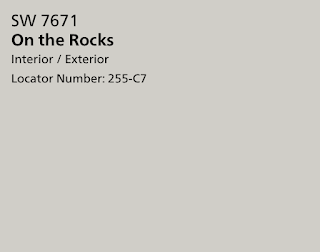Yes, gray is trendy, and trends change. But my love of gray is not an attraction that’s likely to fade: Way back in the early 2000s, when my best friend and I were aspiring (i.e. 12-year-old) interior designers, we’d often fantasize about painting a dining room gray. Back then, no one had gray walls—everything was that hideous shade of faux-Mediterranean yellow-gold—and even now, more than a decade later, I stand by my preteen design impulse. In my book, gray is always a go, no matter how trendy (or not) it is.
Problem is, as gray has grown in popularity, the number of paints to pick from has proliferated. So how the heck do you choose the right gray for your walls?
 |
| Gray works in every room; the challenge is deciding which shade of gray is best! (Photo: GreigeDesign.com) |
The solution: Use science to help you decide.
In researching wall colors for my new home, I came across an interesting (and helpful) concept: light reflectance value (LRV). It’s something listed on the back of paint swatches, which is, admittedly, a place I’ve never bothered to look. The dumbed-down definition of LRV? Basically, it’s how light or dark a color is, a factor determined by how much light the paint absorbs.
 |
| (Photo: TheLandofColor.com) |
The breakdown: Black absorbs all light, so it marks one end of the LRV scale (0% LRV), and white, which reflects all light, represents the either end (100% LRV). Every shade of gray lands somewhere in between. What that means: If you want a cozy, darker-feeling space, a low LRV paint color is ideal; for a bright and airy vibe, higher LRV is the way to go.
Here are the LRV values of some bloggers’ and designers’ favorite grays, ranging from light to dark:
Benjamin Moore Horizon
 |
| Living room painted with Horizon by Braun + Adams Interiors (Photo: InteriorsbyColor.com) |
LRV: 73
Described by Donna Peay, the writer behind the A Perfect Gray blog, as “a beautiful light gray with just a hint of blue,” this shade is certain to brighten up (and cool down) your space.
Benjamin Moore Graytint
 |
| (Photo: KarenHealeyStables.com) |
LRV Value: 69
Not too dark, not too light, Graytint is perhaps the definition of an unassuming gray.
Sherwin Williams First Star
 |
| (Photo: VeronikasBlushing.com) |
LRV Value: 69
This barely-there gray is the perfect choice for a room in need of a light touch (like the soothing nursery above!).
Sherwin Williams Silverpointe
 |
| (Photo: Houzz.com) |
LRV Value: 64
I had this medium gray all over my previous home: in my second and third story hallways and my daughter’s room, where it was paired with Rhinestone (a whitish-gray) for subtly contrasting stripes.
Sherwin Williams On the Rocks
 |
| (Photo: houzz.com) |
LRV Value: 62
I chose this medium gray for my new home because of its cool undertone (my builder's interior designer described it as having a slightly blue tint), which pairs well with my furniture.
Sherwin Williams Agreeable Gray
 |
| (Photo: houzz.com) |
LRV Value: 60
More greige than true gray, this color is an effortless neutral that blends with almost any color palette. It’s used in my builder’s model home.
Sherwin Williams Silver Strand
 |
| (Photo: HouseofTurquoise.com) |
LRV Value: 59
A favorite of Joanna Gaines, Silver Strand has just a hint of green to it.
Sherwin Williams Repose Gray
 |
| (Photo: Painter1.com) |
LRV Value: 59
Another Fixer Upper regular, this beigey-gray is where the scale starts to skew toward the dark side.
Sherwin Williams Mindful Gray
 |
| (Photo: HomeBunch.com) |
LRV: 48
Think of this as the darker cousin of Repose Gray (Jo-Jo has been known to use both!). As Thistlewood Farms blogger KariAnne Wood describes it: “This is the gray that trumps all others when you just don’t know where to turn. It’s the perfect not-too-green-not-too-pink gray."
Sherwin Williams Dorian Gray
 |
| (Photo: kylieminteriors.ca) |
LRV: 39
This gray is on the darker side of medium, with a slightly greige undertone.
Benjamin Moore Dior Gray
 |
| (Photo: homebunch.com) |
LRV: 22
Interior designer—and Oprah favorite—Nate Berkus has called this dark gray his fail-safe shade, for its elegance and classic appeal.
Farrow & Ball Down Pipe
 |
| (Photo: moderncountrystyle.blogspot.com) |
LRV: 13
Farrow & Ball describes this shade as a “dark lead gray” with blue undertones. Perfect for a moody library.
Benjamin Moore Cheating Heart
 |
| (Photo: caitlinwilsondesign) |
LRV: 9
This charcoal gray will make a bold statement on your walls or help draw the eye to little details, like the legs of a clawfoot tub, as designer Jen Going suggests.























































